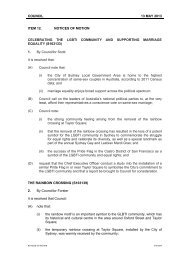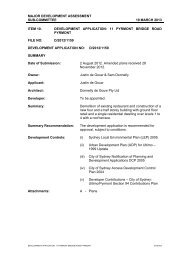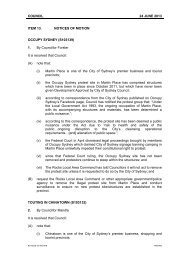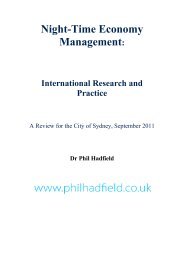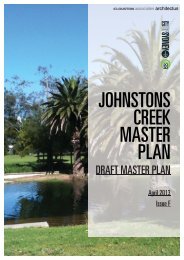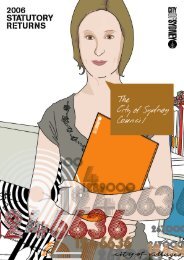Histories of Green Square - City of Sydney
Histories of Green Square - City of Sydney
Histories of Green Square - City of Sydney
Create successful ePaper yourself
Turn your PDF publications into a flip-book with our unique Google optimized e-Paper software.
<strong>Histories</strong> <strong>of</strong> <strong>Green</strong> <strong>Square</strong><br />
Alexandria and Waterloo, however, were under no such obligation<br />
to conform with the <strong>City</strong> <strong>of</strong> <strong>Sydney</strong> Act. Even by 1890 it<br />
was noted that no building regulations existed in the suburbs.<br />
Sewerage construction had not begun, even though the 1867<br />
Municipalities Act had empowered councils to do so; cesspits<br />
were still common and even the pan system <strong>of</strong> sewage collection<br />
had not been established. 27 This contributed to making<br />
life in the suburbs more difficult than in the <strong>City</strong>. It is fascinating<br />
that, at a time <strong>of</strong> supposedly increased regulation<br />
by the state and local governments, in places like Waterloo,<br />
authorities failed to properly regulate housing, and neglected<br />
basic public health issues, such as sewerage and clean water.<br />
It is clear that the laissez-faire approach to <strong>City</strong> and suburban<br />
development at the time <strong>of</strong> major subdivision and housing<br />
development helped create these exceedingly poor conditions.<br />
In this light, we can see the irony <strong>of</strong> attempts to clean up ‘slum’<br />
areas in Waterloo in later decades, as a means <strong>of</strong> fixing what<br />
had been allowed to occur through poor regulation in the first<br />
place.<br />
The impact <strong>of</strong> this neglect can be read in mortality figures.<br />
While the death rate in London during epidemics <strong>of</strong> typhoid,<br />
cholera and diarrhoea in 1864 was 27 per 1,000 people,<br />
the death rate in <strong>Sydney</strong> in 1874 was far worse. During an<br />
epidemic <strong>of</strong> measles and scarlet fever <strong>Sydney</strong> reached a death<br />
rate <strong>of</strong> 32 per 1000, and in Waterloo and Alexandria, this<br />
figure was made worse still by an infant mortality rate which<br />
contemporary sources reported as 46 per cent <strong>of</strong> all births. 28<br />
Life in the industrial outskirts <strong>of</strong> <strong>Sydney</strong> was very hard, and<br />
high mortality rates point to exceptionally unsanitary conditions<br />
in the Waterloo area. (These conditions were not<br />
localised to Waterloo, however. The <strong>City</strong> also suffered from<br />
the same unsanitary conditions, while the outer suburbs, the<br />
domicile <strong>of</strong> the middle class, had similar figures in regard to<br />
infant mortality).<br />
The high rate <strong>of</strong> infant mortality might be attributed to a<br />
lack <strong>of</strong> adequate hospital facilities; perhaps malnutrition and<br />
poverty played a part. As Fitzgerald points out, Alexandria had<br />
no doctors at all. 29 But these were secondary to poor sanitary<br />
conditions, which contaminated water and heightened the<br />
risks <strong>of</strong> epidemics such as cholera and typhoid. By contrast,<br />
the benefits <strong>of</strong> sewerage, drainage and fresh water supplies,<br />
when and where they came, were dramatic. In <strong>Sydney</strong>, after<br />
extensive sewer extensions in the late 1880s and the completion<br />
<strong>of</strong> the new Nepean water supply scheme, the death rate<br />
dropped from 19 per 1000 to 15.2—most <strong>of</strong> this figure in<br />
infant mortality. 30 But lack <strong>of</strong> basic urban services in Waterloo<br />
continued to be the great scourge <strong>of</strong> the suburb.<br />
So, while Waterloo was quickly painted with the ‘slum’ brush,<br />
it is also clear that the people themselves were disregarded,<br />
they were unimportant, out <strong>of</strong> sight. Or they were blamed<br />
for the apparent squalor in which they lived—as if it were<br />
somehow their fault, because <strong>of</strong> the type <strong>of</strong> people that they<br />
were. In one sense these people were also victims <strong>of</strong> the wider<br />
problems <strong>of</strong> the delayed development <strong>of</strong> infrastructure in the<br />
city as a whole. The most basic and fundamental needs were<br />
ignored, unfunded or considered not feasible for decades; such<br />
problems were <strong>of</strong> course magnified at the <strong>City</strong>’s fringes.<br />
7.3.3 Suburban planning in the 1880s<br />
While <strong>City</strong> planning and infrastructure left a lot to be<br />
desired, planning <strong>of</strong> the suburban areas was by comparison<br />
dismal. Legislation forced industries out <strong>of</strong> the <strong>City</strong>, and so<br />
they moved to places like Waterloo and Alexandria. Tougher<br />
60<br />
building regulations in the <strong>City</strong> meant that it was no longer<br />
as affordable to build there, either. However, the new building<br />
codes, requirements for sewerage, water closets or fresh water<br />
still did not apply in Waterloo when suburban and industrial<br />
development was underway in the 1870s and into the 1880s.<br />
Construction in Waterloo was therefore cheaper and less<br />
stringent than in the <strong>City</strong> Municipality and the mix <strong>of</strong> housing<br />
was being established, in many cases, alongside industry.<br />
Evidence <strong>of</strong> this can be seen in some <strong>of</strong> the twisted streets<br />
<strong>of</strong> Waterloo where the original street was extended to meet<br />
another main road. Lachlan Street, for example, does not<br />
quite meet up with McEvoy, and Phillip Street joins Bourke<br />
and Crescent at an acute angle. Unsuccessful subdivisions<br />
led to the establishment <strong>of</strong> industries on surrounding areas,<br />
which in turn forced alterations to the original plans for roads<br />
and houses. This is really indicative <strong>of</strong> the lack <strong>of</strong> overall<br />
planning in this period <strong>of</strong> land sales and suburbanisation. It<br />
was a totally unregulated market in which almost any building<br />
could be constructed without providing water, sewerage, gas,<br />
proper drainage or roads. If the land could be acquired, then it<br />
could be subdivided and sold.<br />
By 1890, Waterloo and Alexandria had received many <strong>of</strong> the<br />
more undesirable, polluting, smelly and noxious industries,<br />
which had been legislated out <strong>of</strong> both the <strong>City</strong> and more<br />
established suburbs, such as Redfern. While Redfern had<br />
been built out and its low-lying areas drained, the Waterloo<br />
area was still in a state <strong>of</strong> transition. 31 A walk through the<br />
area in 1890 would reveal new housing from recent subdivision,<br />
terraces and ‘many small, ill-constructed cottages, most<br />
<strong>of</strong> them wooden’. 32 New factories had grown up alongside<br />
existing industries such as dairies, market gardens and brickworks.<br />
And there were still spaces in which nothing had been<br />
built at all: sand hills, swamps and vegetation.<br />
The growth that took place in Waterloo over 30 years after<br />
1870 was staggering. Waterloo was transformed from a small<br />
fringe suburb <strong>of</strong> <strong>Sydney</strong>, with some small industry mixed with<br />
market gardens, dairies and mills, to a suburb where larger<br />
scale industry, rows <strong>of</strong> terrace housing and areas <strong>of</strong> workers’<br />
cottages now filled the landscape. Large scale industry would<br />
continued to grow—the area had a dozen industries in 1910;<br />
by 1914 there were over 100. 33 The vast increase in <strong>Sydney</strong>’s<br />
population generally, coupled with the prospect <strong>of</strong> employment,<br />
drew people to Waterloo and fuelled the housing boom.<br />
But not everyone gained from the growth <strong>of</strong> the suburb. An<br />
elite class <strong>of</strong> property investors gained from sale <strong>of</strong> the land,<br />
while factories-owners made small fortunes from manufacturing.<br />
Some artisans would no doubt have been able to purchase<br />
their own handsome brick and stucco houses in Waterloo, but<br />
there were also many unskilled labourers who rented mean<br />
wooden cottages, and existed at subsistence level. 34<br />
7.4 ‘Housing for everyone’: public housing, slum<br />
clearance and development ‘along modern lines’<br />
From the middle <strong>of</strong> the nineteenth century, middle class<br />
attitudes towards the <strong>City</strong> started to change, and their exodus<br />
to the new outer suburbs, especially with the extension <strong>of</strong> tram<br />
and train services, is <strong>of</strong>ten seen as a catalyst for the creation<br />
<strong>of</strong> the slums. The older parts <strong>of</strong> the <strong>City</strong> they abandoned fell<br />
into disrepair and disrepute. 35 However, the evidence gained<br />
from Waterloo, a suburb that was developed after the early<br />
estate holders had ‘left’, suggests that lack <strong>of</strong> planning and<br />
building regulation and failure to provide amenities, were the<br />
real culprits behind creation <strong>of</strong> slums, rather than the socio-<br />
© Jeff Fairman<br />
economic background or moral status <strong>of</strong> residents. Places like<br />
Waterloo need to be interpreted in the light <strong>of</strong> such factors:<br />
the extent to which they were created by the people who lived<br />
in them must be weighed against the circumstances which<br />
were imposed and allowed by those with power, authority and<br />
wealth.<br />
By the late nineteenth century, though, poor housing was <strong>of</strong><br />
increasing concern for authorities and governments. The two<br />
responses—slum clearance and public housing—would both<br />
shape Waterloo in the twentieth century.<br />
7.4.1 The evolution <strong>of</strong> public housing<br />
While urban services in the city were improving in the 1880s<br />
and 1890s, much <strong>of</strong> the housing in the older urban locales,<br />
such as the Rocks, Woolloomooloo and Redfern was in<br />
disrepair and overcrowded. 36 Along with the Rocks, Redfern<br />
was the most densely populated in the 1880s and 1890s, and<br />
also experienced the greatest growth rate in <strong>Sydney</strong> during<br />
this time. 37 The outbreak <strong>of</strong> Plague in 1900 is <strong>of</strong>ten seen as<br />
evidence for the squalid conditions <strong>of</strong> urban <strong>Sydney</strong>. It was<br />
certainly used by the State government as justification for<br />
slum clearance in and around Miller’s Point and the Rocks<br />
and, as Melita Rogowsky discusses in Chapter 12, was used as<br />
a justification for the demolition <strong>of</strong> Chinese homes in Alexandria,<br />
after an outrbeak <strong>of</strong> plague in 1902. 38<br />
Whereas ‘slums’ were once simply ignored, by 1900, and<br />
with the election <strong>of</strong> a Labor government, ideas <strong>of</strong> ‘development<br />
along modern lines’ were increasingly adopted. 39 This<br />
meant that slum areas were to be identified, knocked down<br />
and ideally, if not <strong>of</strong>ten actually, replaced by modern forms <strong>of</strong><br />
public housing. In response to the need for more housing at a<br />
cheaper price, and the constant threat <strong>of</strong> disease and unsani-<br />
Fig. 7.6 Aerial view <strong>of</strong> the Rosebery Model Estate in 1924,<br />
showing the progress <strong>of</strong> building and the gaps still evident, as<br />
well as the remaining natural environment in this period, particularly<br />
the sandy nature <strong>of</strong> the soils. (Source: Building: The<br />
Magazine for the Architect, 12 September 1924, courtesy State<br />
Reference Library, State Library <strong>of</strong> New South Wales.)<br />
© Jeff Fairman<br />
Chapter 7 – Waterloo: Whose fault were the slums?<br />
tary conditions, the government set about cleaning up and<br />
regulating the less desirable <strong>of</strong> <strong>Sydney</strong>’s suburbs. These ideas,<br />
now known as ‘urban renewal’, finally arrived in Waterloo in<br />
the 1940s and 1950s and reached a peak in the 1960s. This<br />
resulted in a dramatic reshaping <strong>of</strong> the built environment.<br />
Successive redevelopments have left Waterloo a patchwork <strong>of</strong><br />
different public housing styles, some experimental, ranging<br />
from two-storey houses to towering high-rise blocks.<br />
After the Second World War it was estimated that <strong>Sydney</strong><br />
required up to 300,000 new homes, thus creating the great<br />
boom in housing development in the suburbs. 40 For Waterloo,<br />
this meant intensification <strong>of</strong> slum clearance in some <strong>of</strong> the<br />
most run-down areas and replacement with two and threestorey<br />
walk-up flats. Further experimentation during the 1960s<br />
in public housing ultimately resulted in the Endeavour Estate,<br />
planned to include six thirty-storey buildings, each housing<br />
2,000 residents. High-rise housing and increased density were<br />
seen as the answer to the problem <strong>of</strong> housing shortage, and<br />
considered most suitable for the elderly for whom two <strong>of</strong> the<br />
blocks were intended. 41 But obvious drawbacks, such as a<br />
lack <strong>of</strong> elevators, made access for the elderly difficult, and the<br />
imposing height and dense occupation <strong>of</strong> the buildings was<br />
out <strong>of</strong> character with the rest <strong>of</strong> Waterloo.<br />
Objections raised by the local residents in 1972 to high-rise<br />
redevelopment in Elizabeth Street led to the imposition <strong>of</strong> a<br />
<strong>Green</strong> Ban by the Builders Labourers Federation, and forced<br />
the government to reconsider its plans for Waterloo. It also<br />
forced the consideration <strong>of</strong> public interest and opinion in<br />
planning schemes. As a result, plans for Waterloo now include<br />
a rehabilitation program for buildings in the area, rather than<br />
bulldozing them. 42 It was a long road to recognition <strong>of</strong> the<br />
importance <strong>of</strong> the neighbourhood, especially in the face <strong>of</strong><br />
some stringent opposition to preservation <strong>of</strong> the old buildings<br />
by a government that saw little value in them. Assumptions<br />
about what constituted ‘heritage’ are clear in the Housing<br />
Commission’s 1974 statement:<br />
Preservation <strong>of</strong> fine old buildings is <strong>of</strong>ten worthwhile<br />
and can add to the charm and historic interest <strong>of</strong> a<br />
city. This area has been selected for redevelopment<br />
precisely because it contains few, if any, buildings<br />
worthy <strong>of</strong> preservation. 43<br />
This report also included two draft plans for thirty-storey<br />
high-rise buildings and walk-up flats, and clearly shows<br />
just what urban renewal actually meant. Largely because <strong>of</strong><br />
resident action in the 1970s, urban renewal now represents<br />
something more than mere modernist slum clearance projects.<br />
In Waterloo, there has been a shift away from demolition as<br />
the unquestioned way to reshape the neighbourhood, for the<br />
program seeks to preserve and highlight those buildings that<br />
have cultural significance to the local area.<br />
7.4.2 Rosebery, the ‘Model Industrial Suburb’<br />
Another response to the need for public housing, and one<br />
more popular than high-density high-rise, was the ‘model<br />
suburb’. For the first time, an attempt was made to fully plan<br />
and lay out the entire suburb, including roads, parks, schools<br />
and infrastructure, before it was built. The model suburb represented<br />
all that modernity could <strong>of</strong>fer in terms <strong>of</strong> the best<br />
possible environment to live in. The first such planned suburb<br />
was the Daceyville model suburb, originally Dacey Garden<br />
Suburb, which commenced in 1912. By 1913 over 100 houses<br />
had been constructed on the site, all <strong>of</strong> which were for lower<br />
middle class and working class people, who were selected by<br />
61



